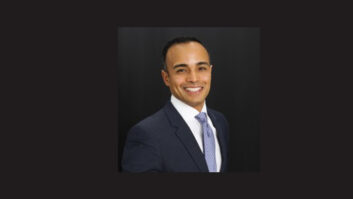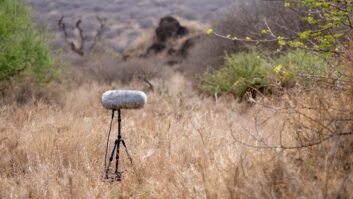
Sprint has developed a Web landing page to promote the NextRadio FM App. The NextRadio FM app has an 85 percent retention rate, which means consumers are “downloading, listening and coming back for more,” according to Emmis Communications, the broadcast group owner that developed the app at the request of NAB Labs and is hoping the industry will adopt it widely.
“Everyone can do this,” said Senior Vice President/Chief Technology Officer Paul Brenner. “Because the over-the-air tuner is FM, we can measure what they do with the app.” That includes tracking how many people liked a song or dropped it, for example.
The NextRadio app provides local over-the-air reception in smartphones with enabled FM chips, and adds interactive features, if stations opt to support them, such as buying and rating songs, social media coupons and geo-location services, all using the phone’s data channel.
Emmis has invited other broadcasters to participate in the enhanced display and interactivity opportunities. Stations can use Emmis’ Web-based TagStation to provide data services for broadcasts and deliver interactive elements to the app.
Nineteen radio groups (see sidebar) have signed on and will pay to deliver interactive services with TagStation; only a few hundred stations were delivering interactive elements as of early October.
Not on the list are industry biggies Clear Channel and Cumulus; they are in discussions with NextRadio and “are showing some interest in helping in this initiative,” according to Brenner.
EARLY ACTIVATIONS
Sprint launched NextRadio in its HTC One and EVO smartphone models. The app can also be downloaded on some older HTC models. Just after the Radio Show in Orlando, Sprint released a third phone with the pre-loaded NextRadio app and active FM chip, the Samsung Galaxy Note 3.
In Orlando, Emmis said users had tuned to approximately 3,300 over-the-air stations using the app; that number had grown to 3,700 just after the show, Emmis and Sprint executives told attendees of a New York Market Radio Association advertising event.
There had been about 35,000 NextRadio app activations as of early October. Sprint’s launch of the Samsung Galaxy Note 3 “gave us a bump in daily install rates,” Brenner told Radio World.
Sprint has said that its entire product line of smartphones eventually will have active FM chips and come loaded with the app. Emmis Chair/President/CEO Jeff Smulyan said, “We want to be in 300 million phones. For the first time, we have a carrier going to manufacturers saying ‘Put it in and let’s focus on it.’ We’re convinced if our customers like this, this will spread to every carrier in America.”
At the NYMRAD event, Sprint Vice President of Product David Owens promised that “tens of millions of [Sprint] smartphones” would have the feature. According to participants of a NYMRAD panel, the app can increase music sales and exposure, and apply revenue-generating capabilities to other advertising categories. RCA Records Executive Vice President/General Manager Joe Riccitelli described the power of the “buy” button on the app.
Just before the Radio Show, Sprint, HTC, NextRadio and participating stations using full TagStation to supply content for interactivity began a beta marketing rollout in eight cities: Austin, Boston, Chicago, Houston, Kansas City, Las Vegas, Los Angeles and New York.
Who’s Delivering Interactivity? Nineteen radio groups, listed below, are going beyond the basic free level and supporting NextRadio with full TagStation content to deliver album art and interactivity, according to Emmis. Some, like CBS Radio and Hubbard, are delivering full data capability on all of their stations, while a shorter list are starting with some stations and growing to add interactivity to all of their stations over time.Beasley Broadcast Group
Bonneville
Bott Radio Network
Carter Broadcast Group
CBS Radio
Cromwell Group
Emmis
Entercom
Greater Media
Hall Communications, Inc.
Hubbard Radio
Lincoln Financial Media
Merlin Media
Radio One
Radio Training Network, Inc.
Rome Radio Partners
Univision
Wilks Broadcast Group
YMF Media LLC SPRINT ‘PLEASED’
Sprint is “very pleased” with results of NextRadio, and the company has noticed that app users are listening for an average of more than one hour per day, according to Sprint Director of Product Development Mark Yarkosky. Brenner said one user in Hawaii listened for about six straight hours.
Just before the Radio Show, Sprint introduced special signage and other retail marketing materials related to the app, including a JBL headphone promotion. The box includes a NextRadio logo. Sprint has also developed a Web landing page (Sprint.com/landings/nextradio/) to promote the feature.
By the holidays the industry should see more Sprint phones rolling out that contain the NextRadio app, as well as a campaign featuring a “day in the life” of a Sprint phone user. That “day” will include FM listening, Brenner said.
However, radio needs to do its part, he continued.
“We’ve made the first payment to Sprint. Now we have to start the process of rolling out inventory,” Brenner noted, referring to the $15 million a year for three years in spot inventory that the radio industry committed to Sprint. Brenner declined to clarify or discuss payment specifics.
Some industry executives appealed for more stations to take part. NRG Media President/CEO Mary Quass said, “We need to be on the devices people are using.”
Brenner said some 2,700 stations are visually represented in NextRadio through the TagStation content service. Of that figure, 2,450 are using the basic, free level of integration, meaning they uploaded logos to display default artwork in the NextRadio app. The rest, some 260 stations, are using the paid version of TagStation to deliver album art and other interactive elements.
Engineers with whom Radio World spoke said the number of stations delivering interactive elements is still small because of limits in money, time and resources. “Other things are bombarding us,” said one engineer for a major radio group.
Emmis is trying to get more industry support behind the effort. “We need as much content as possible if the FM smartphone initiative is to succeed,” according to Brenner. The small number of stations delivering interactivity is “the number one complaint by the NextRadio listener.” He reported listeners saying they “love the FM radio” but are “highly disappointed that radio cannot at least have album art and artist/title” elements to be on par with other listening apps.
On average, stations with album art or other visual and interactive elements get twice as much listening as stations that have solely the free logo, according to NextRadio.
HD Radio developer iBiquity Digital has been talking to wireless carriers about adding a digital radio component to a smartphone’s FM radio capability. Both iBiquity and Emmis call that a logical next step.
President/CEO Bob Struble told Radio World, “It’s critically important for radio to be on phones in general, because we’ll come to some point in the not-so-distant future when nobody carries anything but a phone. There’s no more portable radios. There’s no more Walkmen. There’s no more headphone radios. It’s all on the phone. So, if we’re not on the phone we’re going to be missing a significant piece of the audience.”
The wireless industry is watching to see how the rollout goes.
In early October, a wireless industry executive told a subcommittee meeting of the House Transportation and Infrastructure Committee that he sees the Sprint-NextRadio deal as a test case for whether other carriers would activate embedded FM chips in their smartphones.
Chris Guttman-McCabe, executive vice president of CTIA — The Wireless Association, was asked during a hearing on alerting why more carriers don’t include FM capability in their smartphones. He noted that the association’s 32 handset makers and carriers compete against one other. “If that sells, and is successful, I have a sense that you’ll see it in many, many more phones; and if it doesn’t, you’ll see it in less. That’s how the market works.”












